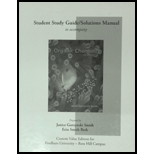
Concept explainers
(a)
Interpretation: The explanation corresponding to the given statement that the
Concept introduction: The
(b)
Interpretation: The explanation corresponding to the given statement that the
Concept introduction: The
Want to see the full answer?
Check out a sample textbook solution
Chapter 19 Solutions
Organic Chemistry -Study Guide / Solution Manual (Custom)
- Write an equation for the acid-base reaction between 2,4-pentanedione and sodium ethoxide and calculate its equilibrium constant, Keq. The pKa of 2,4-pentanedione is 9; that of ethanol is 15.9.arrow_forwardCalculate the Ka's for the following acids: (a) Citric acid, pKa = 3.14 (b) Tartaric acid, pKa = 2.98arrow_forward1. Dimethyl disulfide, CH,S-SCH, found in the vaginal secretions of female hamsters, acts as a sexual attractant for the male hamster. Write an equation for its synthesis from methanethiol. 2. Write an equation for the reaction of ethylene oxide with a. I mole of HCI b. excess HCI c. phenol +H d. phenylmagnesium bromidearrow_forward
- Benzoic acid (C6H5C02H) has Ka =6.3 x 10-5 a) What is the value of Kb for the benzoate ion (C6H5C02-)? b) What is the h30+ concentration of a O, 10 mol/dm3 solution of benzoic acid? c) What is the pH of the solution in (b) above?arrow_forwardChoose the best reagents from the list provided below for carrying out the following conversion. Match the reagent with the step number. HCl (aq), Zn(Hg) KMnO4, H3O+ CH3Cl, AlCl3 HNO3, H2SO4 Cl2, FeCl3 fuming sulfuric acidarrow_forwardFor the Reaction: NH3+ H2O = NH4+ OH- When adding NH3+ phenolphthalien+ HCl What stress is applied and what direction does the equilibrium shift? When adding NH3+ phenolphthalien+ NH4Cl What stress is applied and what direction does the equilibrium shift? When adding NH3+ phenolphthalien+ NaOH What stress is applied and what direction does the equilibrium shift? When adding NH3+ phenolphthalien+ HCl What stress is applied and what direction does the equilibrium shift?arrow_forward
- Identify the reagents necessary for the reaction:arrow_forward2-cyanophenol (pka 7.0) is even more acidic than the 4-cyanophenol isomer. Propose an explanation of why it is so.arrow_forwardWhat is the best choice of reagents to achieve the following reaction? A. SOCl2 (1/2 equivalent) B. KOH (pellets) C. K2SO4 D. PhCO2Naarrow_forward
- Identify the best reagents to console the following reactionarrow_forwardSelect the most likely route to produce the desired products from the given starting material. a. (1) H2SO4 y ∆; (2) HBr b. (1) KOH etanol; (2) HBr c. (1) KOH etanol; (2) HBr + peroxidosarrow_forwardExplain each statement. a. The pKa of p-nitrophenol is lower than the pKa of phenol (7.2 vs. 10). b. The pKa of p-nitrophenol is lower than the pKa of m-nitrophenol (7.2 vs. 8.3).arrow_forward
 Organic ChemistryChemistryISBN:9781305580350Author:William H. Brown, Brent L. Iverson, Eric Anslyn, Christopher S. FootePublisher:Cengage Learning
Organic ChemistryChemistryISBN:9781305580350Author:William H. Brown, Brent L. Iverson, Eric Anslyn, Christopher S. FootePublisher:Cengage Learning

